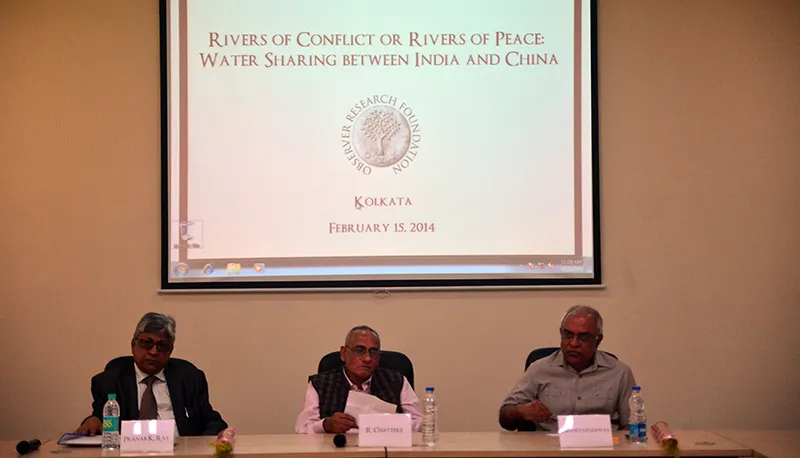Needs Based Sharing Model and hydro diplomacy were among the many solutions that were suggested by experts at a discussion on "River of Conflict or Rivers of Peace - Water Sharing between India and China'' at Observer Research Foundation, Kolkata.

The bilateral opacity between India and China is taking its toll on optimum water sharing by the countries, according to Dr. Pranab Kumar Ray, former professor, Department of Geography, Presidency College.
Speaking at a discussion on "River of Conflict or Rivers of Peace - Water Sharing between India and China’’ at Observer Research Foundation, Kolkata on February 15, Dr. Ray said although India and China are two pivotal powers of the region, they have many issues at stake as far as water sharing is concerned. For instance, the Great Bend site in Tibet which is a lucrative option for building dams by China may countered by apprehensions surrounding Subansiri dam site in India.
Dr. Ray said lack of transparent sharing of hydrological data also continues to hinder water sharing among South Asian countries.
Dr. Ray mentioned several theories or doctrines of water sharing among States - Absolute Territorial Sovereignty (Harmon Doctrine), Theory of Sovereign Equality and Territorial Integrity(pre-1966), Helsinki Protocol (1966), United Nations Convention on Inter-State Rivers (1997), etc.
He offered a vivid hydrological description of the Yarlung Tsangpo- Brahmaputra-Jamuna system. He mentioned that India has 33.6% of the basin whereas discharges 42% of river water, 50.5% of basin area is occupied by Chinese territory of Tibet and discharges 36%, Bhutan covers 7.8% of area and discharges 15%, and Bangladesh discharges 8% of water and covers 8.1% of basin area. In terms of average rainfall in the Indian sub-continent, the highest receivers are western peninsular India and parts of north-eastern India whereas the lowest receiving areas lie in upper Tibet and Afghanistan.
The total hydropower potential of the Yarlung Tsangpo- Brahmaputra-Jamuna system is 200,000 MW. Despite enormity of resources, there are several conflicting interests surrounding run of the river, hydro-power generation and its consumption in irrigation. For instance, Dhaka and Delhi do not see eye to eye on water availability for irrigation, hydropower generation as well as navigation in the Seven Sister States of India.
China is also an important claimant of water in the region. This is because providing irrigation facilities to dry Tibetan plateau is a major challenge for China while meeting its hydroelectricity-generation and navigational demands. Also ground water resources are highest in India and extremely low in China. However, potential glacial melt volume from ice-fields is far more in China than India. Melting glaciers are a serious problem for the world today and situation is quite adverse in China. China has been fast changing positions on claiming its share of water in the region. In 2010 itself, China has changed her position twice on building a dam on Tsangpo.
Dr. Ray categorically stated that if India wants to look east, the issue of hydropower facilitation to North Eastern states must be dealt with more sincerity. In identifying the bone of contention in the region, he singled out that lack of willingness by countries to officially share data in public domain remains a major obstacle. No water sharing treaty has materialised so far between India-China, China - Bangladesh, India-Bhutan.
After a detailed analysis of the situation, Dr. Ray suggested some solutions. He emphasised on a Needs Based Sharing model. The policy framework for this model includes execution of water sharing treaty (surface and ground) on bilateral and multilateral basis and transparency on exchange of data. This must give way to development of a larger neighbourhood policy which incorporates interests of key stake-holders as well as extra-basin regional stakeholders. v This model must be well placed in its geo-political context. The policy must be an outcome of discussions by all stakeholders of the Brahmaputra basin. This must be supplemented by tripartite policy on water sharing between the countries, NGOs and INGOs. Eventually, an intra-basin transfer and open marketing for products of water management thorough transit from upper Yarlung Tsangpo to Ganga - Bay of Bengal circuit must be adopted. Overall, the policy must be attuned to sustainable and conservative uses.
Prof. Jayanta Bandopadhyay, formerly with the Indian Institute of Management, Calcutta, agreed with Dr. Ray’s views that lack of official data is a major impediment to genuine research on water. He was of the view that whatever is available on table is an admixture of many generalities without mention of specific problems or breakthroughs. A great deal has been written by NGOs on transportation of water to dry northern plains of China. Economically, such physical transportation is not viable. However, hydropower transfer is perfectly possible.
He also stated that use of water in food grains makes the whole issue of water all the more salient. It gets associated with broad ideas of poverty, food security, and accessibility to riverine products. As a natural corollary, water must be addressed from a multi-disciplinary and integrated approach. He prescribed a river basin solution to region’s water sharing predicament. He also felt there was a necessity to evolve a South Asian variety of ’hydro diplomacy’.
The views expressed above belong to the author(s). ORF research and analyses now available on Telegram! Click here to access our curated content — blogs, longforms and interviews.




 PREV
PREV

